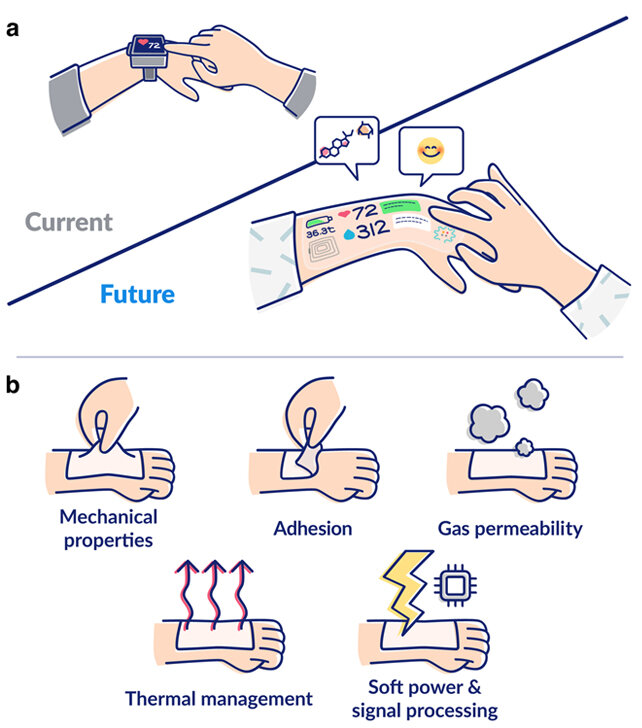Research outcomes of the Program for the Promotion of Next Generation Research Projects
Faculty of Science and Technology, Keio University
(Currently: Institute of Industrial Science, The University of Tokyo)
Naoji Matsuhisa
Wearable devices, such as watches or rings, have become commonplace in recent years. These devices are an important step forward in human well-being because they allow for long-term healthcare monitoring. The biological data obtained from wearables can be used to detect and prevent diseases in their early stages and provide recommendations for a healthier lifestyle. However, there are a significant number of people who are hesitant to wear the current generation of wearables due to them being uncomfortable to wear. For example, some people do not like wearing wristwatches because the resulting sweat can irritate their skin. Additionally, it can be challenging for example, to get babies to wear them. Comfort-of-wear is likely a critical factor in the widespread adoption of next-generation healthcare monitoring devices.1
We have identified several factors that can improve the comfort-of-wear to design future wearable devices that everyone will be willing to put on (Figure 1). One of these factors is mechanical properties. Many current wearables have rigid and small form factors (physical shape and size) because they are made of traditional electronic materials. Meanwhile, our skin is soft and can easily change in shape. This mismatch in mechanical properties can induce a feeling of discomfort with wearables. Recently, soft and stretchable electronic materials have been developed that can match the mechanical properties of our skin.2 When properly adhered, these materials allow devices to be applied to the skin and match its shape, without interfering with the wearer's activities. However, some electronic components, such as silicon circuits and batteries, do not easily lend themselves to being made from soft materials.
It is important to design future wearable devices from a system-level perspective to avoid direct contact between rigid components and the skin. Possible solutions may involve the wireless operation of soft devices or designing them to be self-powering.3 Other factors to consider in the design of future wearables include gas permeability and thermal management. To ensure that the devices can be worn for long periods of time, the skin should be able to breathe and allow for heat to be released from the body through the skin-conformable devices.
In addition to the physical properties of wearable devices, the aesthetic impression of the device can also significantly impact a person's decision on whether or not to wear it. In some situations, people may not want others to know they are wearing one at all. Transparent wearables may be able to address this issue. We have developed highly transparent and stretchable conductors by modifying a non-stretchable conducting polymer. These transparent and stretchable polymer conductors can be patterned in high resolution (<10 µm), allowing us to create high-density stretchable sensor arrays. For example, we have created a stretchable touch sensor array that can be attached to any surface, including the hand, and used as an input interface for smartphones. We have also created a strain sensor array that can be used to measure pulse wave signals. Additionally, our transparent and stretchable conductors can be used to fabricate a stretchable electrochromic display that is soft and thin, providing high skin conformability.
In the future, wearable devices will significantly improve the comfort-of-wear, which will revolutionize healthcare monitoring and our interactions with computers.
This work was partially supported by the Program for the Promotion of Next Generation Research Projects.

Figure 1.
Approaches to aim the ultimate comfort-of-wear in wearable devices.1 a, Schematics of current and future wearable devices. b, Criteria to decide the comfort-of-wear.
Reference
- Shimura, T., Sato, S., Zalar, P. & Matsuhisa, N. Engineering the comfort-of-wear for next generation wearables. Adv. Electron. Mater. 2200512 (2022).
- Matsuhisa, N., Chen, X., Bao, Z. & Someya, T. Materials and structural designs of stretchable conductors. Chem. Soc. Rev. 48, 2946-2966 (2019).
- Matsuhisa, N. et al. High-frequency and intrinsically stretchable polymer diodes. Nature 600, 246-252 (2021)
Keio University Program for the Promotion of Next Generation Research Projects
The Keio University Program for the Promotion of Next Generation Research Projects subsidizes research costs with the aim of finding solutions to challenges and of promoting global academic research in order to allow Keio University faculty members to establish a presence as core researchers.